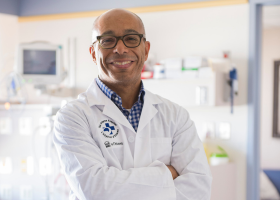Tiny Cells for Tiny Lungs
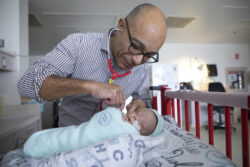 “Stem cells used to be something that were grown in a petri dish. They are now game-changing therapies with live-saving potential for even the tiniest of patients.”– Dr. Bernard Thébaud
“Stem cells used to be something that were grown in a petri dish. They are now game-changing therapies with live-saving potential for even the tiniest of patients.”– Dr. Bernard Thébaud
Dr. Bernard Thébaud listens to the lungs of a preterm baby. Courtesy of The Ottawa Hospital.
Clinical trials are the driving force behind medical progress, offering hope to patients, saving lives through innovative treatments, and propelling the boundaries of scientific knowledge.
The Stem Cell Network sat down with Dr. Bernard Thébaud to discuss his world-first clinical trial, which is using a stem cell therapy to help prevent the development of bronchopulmonary dysplasia (BPD), a chronic lung disease in preterm babies. So far, nine babies have been treated as part of this safety trial, and importantly, the first few babies have been able to go home with their parents – a significant milestone for Dr. Thébaud and his team.
Q: Thanks for taking the time to join us Dr. Thébaud! This is a world-first! What does it feel like to have this trial up and running? What does it mean for the families and the future of the field?
A: Dr. Bernard Thébaud: It’s a dream come true. Research at the lab is interesting, but what is important is to make an impact and a difference for patients, and that’s what we’re trying to do. I would rather never publish another paper and instead work on getting therapies into patients and show that it works. It’s an amazing feeling for our research team, because we have been working toward this moment for 18 years. It didn’t happen overnight. It was a very careful, thoughtful process of doing the studies in the lab to show that cell therapy can potentially protect the neonatal lung, and then also to complete the clinical translation. We were also very deliberate in working with parents in asking them how they would feel about such a clinical trial. And I think each of these pieces combined has led to a great phase one trial, which is focused on testing the feasibility and safety of mesenchymal stromal cells – or MSCs – to promote lung growth.
For families this clinical trial is really important because there’s nothing more important than their newborn, and they are already very stressed when they learn about preterm birth. In neonatology there have been breakthrough therapies over the years, but they are all now 30 years old.
We hope that if we can show the efficacy of these cells and improve the outcomes for preterm babies, that this cell therapy will one day be applied around the world to save the lives of preterm babies. Of course, first we have to show this in a phase 2 clinical trial, and it’s still a long journey. But, so far, the phase 1 clinical trial is very promising.
Q: That’s wonderful news, congratulations on such important progress in your research. Now, to dive a bit deeper, your team is focused on using stem cell therapy to help prevent the development of ‘BPD.’ Tell us a bit about BPD. What is it and how does it affect preterm babies and their development?
A: Dr. Bernard Thébaud: BPD stands for bronchopulmonary dysplasia, and it’s a chronic lung disease in babies born too early. When babies are born too early, before 28 weeks gestation or 12 weeks before their due date, we know that their lungs are still growing – they’re not fully developed and they have trouble taking in oxygen. These babies often need to be mechanically ventilated and assisted with a machine that gives them additional pressure and oxygen. And while this intervention keeps them alive, it also causes some degree of injury.
BPD is one of the most frequent complications of preterm birth. And the reason why it’s such an important problem and why it’s worth tackling is that babies who have BPD often also are at risk for blindness or neurodevelopmental deficiencies. So, in short, if we treat BPD there will be several benefits for these babies.
Q: So, backing up a bit, can you describe the science? How exactly are stem cells used in the treatment?
A: Dr. Bernard Thébaud: The idea was born from the regenerative properties that we ascribe to stem cells. The stem cells that we are interested in can be isolated from the umbilical cord. And the beauty is that the umbilical cord is right there at birth, and from it we can extract a lot of mesenchymal stromal cells or MSCs. These particular cells seem to be very good at bringing down inflammation. You see, BPD has an inflammatory component, and this is why we believe that these cells can be beneficial in the treatment and prevention of BPD. We have done extensive studies in the laboratory to show that if we inject these cells into models that mimic BPD, we can protect the lungs and attenuate the inflammation. And we believe that in addition to attenuating, these cells can also promote lung growth.
 Emmy Cogan was the first baby treated in a world-first clinical trial of a cell therapy for bronchopulmonary dysplasia. Courtesy of The Ottawa Hospital.
Emmy Cogan was the first baby treated in a world-first clinical trial of a cell therapy for bronchopulmonary dysplasia. Courtesy of The Ottawa Hospital.
Q: The first couple of patients have now gone home. That’s very exciting – what can you share about how the babies are doing? How long do you follow the progress of the babies?
A: Dr. Bernard Thébaud: So far, they’re all doing well. Again, it’s a phase 1 trial so it’s a safety and feasibility study. We don’t have answers yet on efficacy. Having said that, there are important signals from this phase 1 trial that is suggesting that not only are the cells safe, but they may also improve outcomes. There’s one baby for example, who after having received the cell therapy didn’t require post-natal steroids, which is usually unheard of for the type of extreme preterm babies eligible in our trial. They almost all need post-natal steroids. And we also had a baby that was born at 23 weeks, who would usually stay in the intensive care unit up to 44 weeks corrected age, but this baby went home at 37 weeks corrected age, without the requirement for additional oxygen. Clearly, this is impressive.
The next big check-in on the babies is at 24 months at their neurodevelopmental follow up. All preterm babies have this appointment. Even though this won’t be the primary endpoint, I hope that we will see some additional interesting signals at this point. And then after that, we will catch up with the parents every year by phone over a 10-year period to see how their children are doing.
One thing I would add is that this trial we’re talking about is called the HUL-C trial (Helping Underdeveloped Lungs with Cells) – like the comic book character, the Hulk. And the other two projects my lab is working on are called AAvenger and Ironman. Nice acronyms. It keeps our team excited, and we believe that it portrays our tiny patients as the true superheroes.
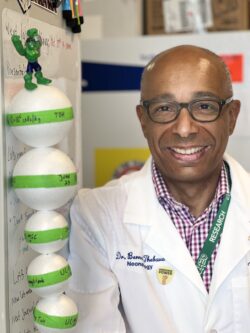 Dr. Thébaud poses next to “the Hulk” which inspired the name of his world-first clinical trial – the HUL-C trial (Helping Underdeveloped Lungs with Cells). The size of the foam balls represents the increase in dosage for patients in the trial.
Dr. Thébaud poses next to “the Hulk” which inspired the name of his world-first clinical trial – the HUL-C trial (Helping Underdeveloped Lungs with Cells). The size of the foam balls represents the increase in dosage for patients in the trial.
Q: How special! You will be an important part of these families’ lives for a long time. Tell us, was there a moment in your clinical trial or in your research that stood out for you?
A: Dr. Bernard Thébaud: At the beginning of the trial, with our very first patient, it was a tense moment because we were working hard to make sure that everything was okay and would go well. We were in the NICU and the nurse had arranged everything and we were set up and ready to go. And when it was time to start the cell therapy through the pump, the nurse tapped me on the shoulder and said, “Bernard do you want to start the pump?” And so, I turned around and I got emotional, I had tears in my eyes at this moment. There I was, so tense and so focused, but when she asked me to press the pump, for the very first baby, I was really emotional. The moment had come. That was something I will never forget.
Another memorable event was long before we started into the clinical trial. I was four years into my independent research career, and I was in the clinic. I was talking to a parent about the problems that her preterm baby had in both lungs, and she asked me: “But, is there nothing you can do for my baby now?” And that sentence changed everything for me. I was excited about my research, but there was nothing that could help now. And so, from that day on, every new idea we take on, every part of our research, is focused on getting therapies to the clinic and to patients to ultimately answer that question from that mother: Isn’t there anything you can do for my baby now? We’re now at a point where we can start to say yes.
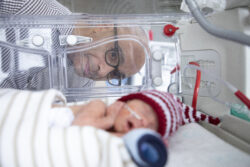 Dr. Thébaud checks in on a preterm baby in the NICU.
Dr. Thébaud checks in on a preterm baby in the NICU.
Q: You’re making us teary-eyed. What amazing moments. Now, for someone who knows nothing about stem cells and regenerative medicine research, what would you say to them to explain the incredible promise of this field overall?
A: Dr. Bernard Thébaud: Unlike a pharmacological therapy, like an antibiotic, for example, or a drug for hypertension, stem cells are living organisms. They are like the building blocks of our body. And unlike pharmacological medications, these tiny cells send signals and interact with other cells in the body and have additional properties that pharmacological drugs don’t have. They can better adapt and repair organs for example, and so this is a completely new paradigm in medical therapy. It took a long time to understand what these cells can do and we’re still working on this of course, but cell therapy is unique. Regenerative medicine really has the potential to revolutionize medicine over the next 20 years.
Q: How do we keep this momentum going? For example, what would you say to policy makers about what’s needed to further stem cell and regenerative medicine in Canada?
A: Dr. Bernard Thébaud: In Canada, we honestly have an amazing stem cell regenerative medicine ecosystem, thanks in large part to organizations like the Stem Cell Network, and the ecosystem itself is very collaborative.
Now that we have created this ecosystem, we need to foster it so breakthroughs can happen. Hopefully we have something game-changing for premature babies. And elsewhere in Canada researchers are doing cutting-edge work with regenerative medicine to one day cure diabetes, for example. This work is happening right here in Canada, and we are leaders in the field. And so in order to maintain that success, we need investment. These successes are happening now. Stem cells used to be something that were grown in a petri dish. And now they are game-changing therapies with the potential to save lives.
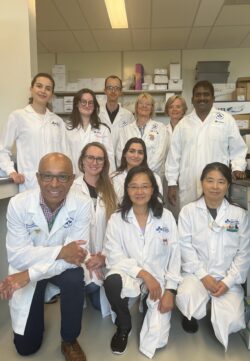 Dr. Bernard Thébaud and researchers of the Thébaud lab.
Dr. Bernard Thébaud and researchers of the Thébaud lab.
Q: You mentioned the Stem Cell Network, which has supported your research since 2007 and has also provided funding for your clinical trial. Why is an organization like SCN important for your research and for the regenerative medicine community in Canada?
A: Dr. Bernard Thébaud: The Stem Cell Network is punching way above its weight. It’s unique in Canada, and unique in the world because they are a true network where researchers, clinicians, and industry professionals meet, exchange knowledge and collaborate in order to have stem cell therapies reach their full potential. SCN offers grants to test very rudimentary ideas right from the beginning, all the way up to clinical trials. And this is unique because sometimes when it comes to actually achieving the translation from the lab to the patient – often called “the valley of death” – this research is not very innovative or exciting, but it is absolutely critical. SCN also offers training for next-generation talent and opportunities for new scientists to get the best possible hands-on experience right here in Canada. SCN is truly a critical part of the regenerative medicine ecosystem.
Dr. Bernard Thébaud is a neonatologist at The Ottawa Hospital and CHEO and senior scientist at the Ottawa Hospital Research Institute and CHEO Research Institute, Professor at the University of Ottawa, and an SCN-funded investigator.
Published September 2023, updated January 2024.

